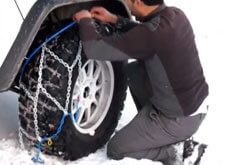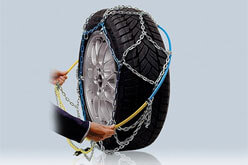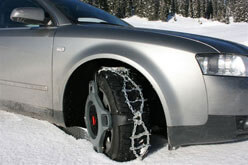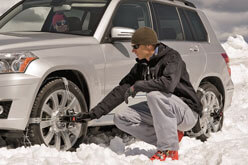Types of chain: Traditional, Automatic, Ladder Track / Front fitting

Traditional snow chains put chain behind the wheel as well as on top of it. They are fitted by pushing a cable behind the wheel at ground level before lifting both ends above the widest part of the wheel, joining them together and then placing them behind the top of the wheel.
There are two types - basic and self-tensioning. If you use basic chains you'll need to stop again after a short distance and re-tighten the chains; if you use self-tensioning chains you won't have to stop again. Self-tensioning chains cost a bit more!

Automatic snow chains also put chain behind the wheel as well as on top of it. The chain, hanging from a sprung steel hoop, is pushed over the top of the wheel. These chains can be pushed into wheel arches where there isn't space for your forearms, and they are also ideal for twin wheeled vans and minibuses.

Ladder track / Front fitting snow chains only put chain on the top of the wheel, so there are no internal "clearance" issues. They are fitted from the outside of the wheel, attached to one or several wheel bolts.
Choose by budget
We display the chains cheapest first. You will know how much you have to spend, and will be able to see what extra you get for increases in budget.

Choose by ease of fitting and removal
The more expensive the chains the easier they are to fit and remove. Expensive chains usually have marginally better performance, but it's marginal - you are paying for convenience. Convenience is usually means 'self-tensioning', which means that you don't have to stop again to tighten them up.
Choose by brand / quality
Our Brands popup has information about why we stock several brands, and what each has to offer.
Please use the filters you see on our snow chains listing pages to help narrow our choice.